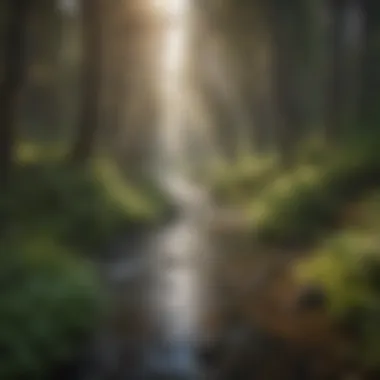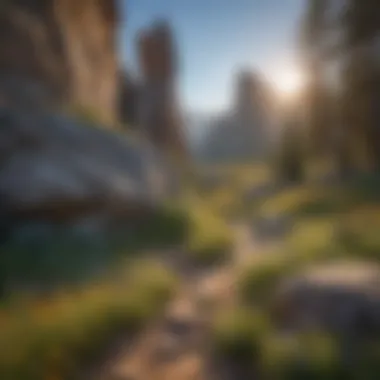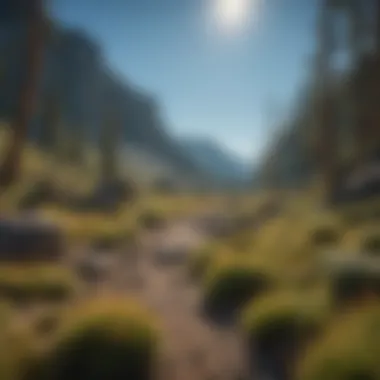Discover the Unique Landscapes of Eastern Oregon


Intro
Eastern Oregon is quite the spectacle. The region is an intricate tapestry of nature’s finest touch, each thread weaving a story that invites the keen explorer. As you wander through Eastern Oregon, you encounter a multitude of landscapes, each with its own unique character and charm. Whether it’s basking in the sun on the high desert or finding solace in the shadows of towering forests, this land is ripe for discovery.
The outdoor adventures are numerous and diverse, appealing to a wide range of enthusiasts. There’s something for everyone, from hiking enthusiasts seeking trails that meander through lush greenery to birdwatching aficionados hoping to catch a glimpse of rare species flitting among the trees.
Let’s embark on this journey through Eastern Oregon, uncovering the ecological significance of its landscapes, the adventures they offer, and the cultural narratives that have played a pivotal role in shaping this remarkable slice of the world.
Prelude to Eastern Oregon
Eastern Oregon represents a mosaic of environments, rich cultures, and intriguing histories. Understanding this region requires a nuanced look into its varied landscapes and the stories they tell. The significance of this section lies in its foundational role in laying context for the subsequent exploration of natural wonders, key destinations, and ecological importance.
Geographical Overview
Eastern Oregon is an expanse that stretches beyond simple boundaries. Encompassing deserts, mountains, rivers, and valleys, this region boasts a kaleidoscope of geographical features.
- High Desert: The vast high desert areas, such as the Harney Basin, create a unique ecological niche, attracting those who enjoy solitude and stark beauty.
- Mountain Ranges: The Blue Mountains and the Wallowas rise dramatically, providing a contrast to the flat, arid lands below. These mountains are not just physical landmarks; they also serve as habitats for diverse wildlife.
- Waterways: Rivers such as the John Day and the Sumpter wind through the region, offering life and recreation for plants, animals, and humans alike.
The interplay of these geographical elements enriches the region's biodiversity, thus making it a fascinating study for professionals in forestry and environmental science.
Cultural and Historical Context
Diving into the cultural and historical tapestry of Eastern Oregon unveils a story marked by resilience, innovation, and cultural melding. The land speaks to the Native American tribes, such as the Nez Perce and the Shoshone, who have inhabited this area for centuries.
- Native American Influence: The cultural narratives rooted in traditions and practices of these tribes continue to resonate today, imparting wisdom to modern conservation efforts.
- Pioneer Settlements: The arrival of settlers in the 19th century transformed Eastern Oregon’s landscapes. Their journeys shaped the region's agricultural practices and community structures.
- Economic Development: Timber, agriculture, and mining have all played pivotal roles in shaping the economy, drawing people to the rich resources contained within this area.
Understanding this cultural backdrop illustrates the symbiotic relationship between the land and its inhabitants, setting the stage for a deeper appreciation of the myriad experiences Eastern Oregon offers.
"The landscapes not only harbor natural beauty but also tell tales of generations, an intricate dance of history and ecology."
In summary, grasping the geographical and cultural nuances of Eastern Oregon contributes significantly to appreciating its diverse landscapes. These aspects interconnect to create a canvas of opportunity for exploration and understanding.
Natural Wonders
The region of Eastern Oregon is blessed with various natural wonders that together highlight its unique geographical and ecological attributes. This section shines a light on the stunning landscapes that shape the area, underscoring their significance not just as visual spectacles, but also for their ecological and recreational value. Understanding the natural wonders of Eastern Oregon enriches our appreciation of the land, inviting both local citizens and visitors to engage meaningfully with the environment.
The High Desert Landscape
Eastern Oregon's high desert is a realm that captivates the senses. Its vastness stretches for miles under a seemingly infinite sky, punctuated by distinct geological features and an array of unique vegetation. The interplay of light and shadow on the arid terrain creates a constantly shifting palette, making each visit an opportunity to view the landscape in a fresh light.
This biome, characterized by sagebrush, juniper trees, and resilient wildflowers, supports a variety of wildlife that has adapted to its conditions. The climate, marked by hot summers and cold winters, also plays a crucial role in shaping the flora and fauna. For instance, the Greater Sage-Grouse thrives here, a species emblematic of the high desert ecosystem. Preservation efforts for such species encompass significant ecological considerations, stressing the need for responsible land management practices. Visitors can expect to encounter unspoiled vistas along routes like the Oregon National Historic Trail, which winds through this striking canvas.


River Valleys and Waterways
The river valleys of Eastern Oregon provide a stark contrast to its desert regions. These riparian zones are often lush and fertile, serving as vital habitats for numerous species including fish, amphibians, and birds. The John Day River, one of the most notable waterways, not only offers a haven for anglers but also showcases the area's geological history through its canyons and black basalt cliffs.
The region's waterways are instrumental for irrigation and agriculture, supporting the livelihoods of communities as they tap into the bounty that these rivers provide. Furthermore, they act as crucial ecological connectors, fostering biodiversity across landscapes. Hiking or simply wandering along these banks affords one a deeper understanding of Eastern Oregon's ecological tapestry.
Mountain Ranges and National Forests
The mountainous terrains of Eastern Oregon are more than just grandeur; they harbor rich biodiversity and are crucial for environmental health. Places like the Wallowa Mountains and the Blue Mountains stand as testament to the geological forces that have shaped this region over millennia. With elevations that invite varied climates, these areas are home to dense forests, alpine meadows, and diverse wildlife.
These mountains are enveloped by national forests, such as the Umatilla National Forest and Malheur National Forest, offering ample opportunities for recreation and eco-tourism. The forests are renowned for supporting healthy populations of deer, elk, and an array of bird species. Additionally, they serve critical roles in carbon sequestration and water filtration, making it essential to promote conservation and sustainable practices in these cherished spaces.
"The majestic mountains of Eastern Oregon form not just a visual backdrop but a vital ecological framework that sustains both wildlife and people alike."
In summation, the natural wonders of Eastern Oregon provide a profound understanding of the region's ecological significance, while offering ample opportunity for recreational pursuits. Engaging with these landscapes deepens one’s respect for the environment, and fosters a shared responsibility to protect these immense natural treasures.
Key Destinations
Exploring Eastern Oregon is like stepping into a vivid tapestry of natural beauty and rich history, where each corner offers a unique chapter waiting to be read. Identifying key destinations is essential, as they embody the heart and soul of this remarkable region. These locations not only serve as gateways to countless adventures but also provide a deeper understanding of the ecological and cultural narratives woven throughout the landscape. Visitors to these sites can immerse themselves in outdoor activities, appreciate biodiversity, and revel in the stories that have shaped Eastern Oregon over centuries.
Burns and the Steens Mountain Region
Burns is a quaint town that stands as the gateway to the magnificent Steens Mountain. This area is not just about stunning vistas; it is a place steeped in history and natural significance. The mountains, towering over the high desert, provide a stunning backdrop for exploration. One can hike through lush meadows, observe the striking geological features, and witness the unique flora and fauna that flourish here.
The Steens Mountain itself is distinguished by its dramatic basalt cliffs and deep canyons, which tell tales of ancient volcanic activity. Trekking along the trails invites moments of reflection and a chance to connect deeply with both nature and history. Visitors should lend an ear to the local stories and Native American legends that give life to these rugged terrains. In brief, Burns and the Steens Mountain Region offer a compelling intersection of adventure and culture, making it an essential stop in Eastern Oregon.
Bend and the Cascade Range
Bend is perhaps the most well-known city in Eastern Oregon, attracting tourists year-round for its vibrant culture and stunning landscapes. Nestled in the shadow of the Cascade Range, this destination presents a remarkable blend of urban amenities and outdoor escapades. The area is famous for a myriad of activities, including mountain biking, white-water rafting, and skiing in the winter months.
What sets Bend apart is its craft beer scene, complemented by picturesque riverfront views. The Deschutes River, winding through the city, is great not just for fishing but also for leisurely walks along its banks. Visitors can indulge in some local brews while enjoying a behind-the-scenes look at the region's brewing heritage, perhaps at an establishment like Deschutes Brewery. This combination of adventure and culture makes Bend and the Cascade Range a prominent destination in the region.
The Historic Oregon Trail
The Historic Oregon Trail is more than just a mark on a map; it's a living testament to the resilience of early pioneers who forged new lives in the West. Stretching across the vast landscapes of Eastern Oregon, remnants of the trail remind us of the arduous journey taken by those seeking new opportunities.
Travelers today can explore sections of the trail, which offer a glimpse into the past and the chance to appreciate the vastness of the land that early settlers traversed. Numerous interpretive sites along the trail, like the National Historic Oregon Trail Interpretive Center in Baker City, provide context through engaging displays and educational programs.
Visiting this iconic trail is not just about following footsteps; it's about understanding the labor and determination that shaped the American frontier. The Historic Oregon Trail remains a key destination for anyone looking to connect with the heart of Eastern Oregon’s history.
The Wallowa Mountains: Nature�’s Retreat
The Wallowa Mountains serve as a spectacular sanctuary for flora and fauna, drawing nature enthusiasts and those seeking solitude alike. Often referred to as the **


Outdoor Activities
When it comes to Eastern Oregon, outdoor activities are the beating heart of its charm. The region, with its striking diversity in landscapes, calls out to nature enthusiasts yearning to engage with the great outdoors. Hiking, fishing, and camping are not just pastimes; they are vital gateways to understanding the ecological complexities and the rugged beauty that defines this area. Engaging in these activities offers both exercise and a deeper connection to the land, enriching one's appreciation for its natural wonders.
Hiking and Trail Exploration
Hiking in Eastern Oregon can feel like stepping into a different world. With trails that meander through stunning high deserts, lush forests, and majestic mountains, each path offers a unique story to tell. Renowned hikes like the John Day Fossil Beds or the trails around the Wallowa Lake provide not only physical challenges but also endless opportunities for photography and bird watching. The unparalleled chance to spot diverse wildlife, from eagles soaring above the Elkhorn Mountains to deer grazing in the evening light, enhances the experience.
Considerations such as carrying adequate gear, planning for weather variation, and understanding regional wildlife are essential for any hiker. Trails can range from easy walks to strenuous adventures. Always remember to stay on marked paths to preserve delicate ecosystems.
Fishing and Water Sports
The waterways of Eastern Oregon are a playground for those who find peace on the water. From the Malheur River to the myriad lakes dotting the landscape, these spots are bursting with opportunities for fishing and water sports. Anglers may find themselves casting rods for trout, bass, and even the occasional steelhead.
Other water-related activities include kayaking and paddleboarding, particularly around areas like the Deschutes River. The tranquil waters not only provide a unique vantage point to appreciate the surrounds, they also serve as a means to unwind. Note that checking local regulations regarding fishing licenses and seasonal restrictions is crucial. Always practice catch and release when necessary to maintain the balance of fish populations.
Camping and Starlit Nights
For many, camping in Eastern Oregon transcends mere recreation; it’s about rediscovering connection with nature. With numerous campgrounds nestled among the pine and fir trees, each nighttime view promises a sky alive with a tapestry of stars. Places like Union Creek or the vicinity of the Hell’s Canyon National Recreation Area invite visitors to pitch their tents right close to natural wonders.
Picture this: after a day filled with hiking or fishing, you settle down by a crackling campfire, with the Milky Way shimmering overhead. Campers are encouraged to leave no trace and respect the land by utilizing established campsite guidelines. Remember, the quiet of nightfall can sometimes give pause to gather thoughts or share stories, reflecting on the day’s activities and the tranquillity of nature.
"Nature does not hurry, yet everything is accomplished." – Lao Tzu
In all its forms, engaging in these outdoor activities not only benefits the individual—physically and mentally—but it also cultivates a greater appreciation for the landscape’s ecological significance. Whether hiking a steep trail, casting a line in glimmering waters, or camping under a blanket of stars, Eastern Oregon offers an abundant array of experiences sure to captivate the hearts of outdoor enthusiasts.
Ecological Significance
The ecological significance of Eastern Oregon cannot be understated. This region is a tapestry of diverse ecosystems, each with its own unique attributes that interact harmoniously within the larger environmental context. From high desert terrains teeming with vitality to verdant river valleys, the biological and ecological wealth in Eastern Oregon provides a crucial backdrop for numerous species, both endemic and migratory.
The biological diversity found in this area not only sustains indigenous wildlife but it also enriches the ecological health of the broader West. Protecting these habitats is paramount because they serve as crucial breeding grounds for many bird species and shelters for various mammals. The interplay between these ecosystems contributes to water purification, soil stability, and the overall resilience of the environment against climate variability.
Biodiversity and Wildlife Preservation
Biodiversity in Eastern Oregon showcases a remarkable array of flora and fauna, embodying a natural heritage shaped over millennia. The contrast between the rugged mountains, sprawling sagebrush plains, and riparian zones creates unique habitats where species flourish.
- Flora: Eastern Oregon is home to many plant species that are specially adapted to thrive in both arid and moist conditions. The presence of endangered species, such as the Oregon silverspot butterfly and the Willow flycatcher, highlights the importance of these ecosystems. Their existence depends on continued preservation efforts and habitat restoration.
- Fauna: Large mammals, such as deer, elk, and even the occasional cougar, roam across vast expanses. Birdwatching is a popular activity here, as over 300 species pass through during migrations. The region supports both avian diversity and localized populations of endangered species which rely heavily on specific habitats.
Preserving biodiversity is not just about protecting individual species; it's about enhancing the resilience of ecosystems as a whole. The loss of even a single species can ripple through the food chain, affecting many others.
Conservation Efforts in Eastern Oregon


Conservation initiatives in Eastern Oregon aim to strike a balance between human activity and ecological preservation. These efforts are multifaceted and involve a variety of stakeholders, from government agencies to local communities.
- Restoration Projects: Key projects focus on habitat restoration, especially in areas impacted by agriculture and urban development. Restoring wetlands and riparian buffers can significantly enhance the local ecosystem's ability to support wildlife.
- Protected Areas: Designated conservation areas, such as Malheur National Wildlife Refuge and the Wallowa-Whitman National Forest, safeguard expansive habitats. These zones not only protect biodiversity but also offer invaluable resources for research and outdoor recreation.
- Community Engagement: Local organizations engage with residents through educational programs, fostering a stewardship mentality among the community. Such involvement is critical, as it empowers individuals to participate in conservation activities, from clean-up campaigns to habitat monitoring.
- Research and Monitoring: Ongoing scientific research plays a vital role in understanding ecosystem dynamics. By tracking wildlife populations and assessing habitat conditions, specialists can inform conservation strategies more effectively.
Cultural Narratives and Heritage
Cultural narratives and heritage enrich the understanding of Eastern Oregon, offering a broader context for the diverse landscapes and the life they support. This region is not merely an expanse of scenic beauty; it encapsulates stories, beliefs, and traditions interwoven through generations. Recognizing the significance of these narratives enables visitors to appreciate the land beyond its physical attributes and fosters a deeper connection with its ecology and communities.
Native American History and Influence
The land that is today known as Eastern Oregon carries the footprints of Native American tribes dating back thousands of years. Tribes such as the Nez Perce, Umatilla, and Klamath have deep roots in this area, cultivating a profound relationship with the land and its resources. Their histories, rich with oral traditions, tell tales of survival, kinship, and respect for nature.
Understanding Native American influence in this region provides insight into sustainable practices that have been honed over centuries. Selecting plants for food or medicine, managing wildlife populations, or navigating the intricate river systems reflects a way of life established long before the arrival of European settlers. For instance, gatherings for seasonal food harvesting were both communal and spiritual, highlighting the importance of shared culture.
"We are all interconnected with the land; what we take, we must also give back." This perspective, often echoed in Native American teachings, emphasizes a holistic approach to the environment that is increasingly relevant today.
Consequently, visitors keen on experiencing this rich heritage can explore historic sites such as the Tamástslikt Cultural Institute. Here, cultural exhibits and storytelling sessions offer a glimpse into the tribal history, immersing visitors in a legacy that continues to thrive.
Pioneer Settlements and Agricultural Development
As the dust settled from the dramatic changes of the 19th century, pioneers arrived with aspirations of agriculture and prosperity. Settlers, fueled by dreams of fertile lands, began to carve out homesteads amid the rugged terrain. They faced harsh weather, unfamiliar landscapes, and the necessity of forging relationships with indigenous communities. This dynamic created an environment ripe for conflict as well as cooperation.
The resilience of these settlers led to the establishment of towns and farming practices that still shape Eastern Oregon's economy today. The region's agricultural development saw the rise of wheat and cattle as prominent industries, contributing significantly to not only local livelihoods but also to statewide agriculture. The principles of hard work, innovation, and perseverance became intertwined with the identity of Eastern Oregon.
A visitors’ interest in exploring these pioneer narratives can be satisfied through heritage sites like the Oregon Trail Ruts or Baker City’s Oregon Trail Interpretive Center. These attractions not only educate about the journey and struggles of early pioneers but also encourage reflection on how these stories continue to influence modern life and community values in Eastern Oregon.
In summary, the cultural narratives stemming from both Native American history and pioneer settlements offer valuable lessons in resilience, sustainability, and respect for history. This perspective underscores the rich tapestry of Eastern Oregon, inviting deeper appreciation for its diverse landscapes alongside its heritage.
Concluding Thoughts
Eastern Oregon, with its expansive vistas and striking contrasts, encapsulates the very essence of nature’s beauty and the complexities of human interaction with it. As we reflect on the diverse landscapes, the region offers insights that extend beyond scenic views; these landscapes tell stories of resilience, adaptation, and respect. The emphasis on nature and tourism is not merely about promoting the region, but rather about fostering a deeper understanding of our connection to the environment.
Evolving Perspectives on Nature and Tourism
In recent years, there has been a considerable shift in how we view nature and tourism. Gone are the days when travel was predominantly associated with mere escapism. Today's visitors often seek educational experiences and a profound connection with the land. This evolution fosters a sense of stewardship towards the environment.
As more people gravitate towards the natural attractions of Eastern Oregon, it’s essential to recognize the balance between enjoyment and conservation. Engaging with the natural world can lead to challenges—overcrowding, ecosystem strain, and the erosion of cultural sites. Nevertheless, such challenges inspire innovative solutions. Many local organizations and advocates emphasize sustainability, suggesting that tourists partake in activities that leave no trace and promote ecological health.
For example, educational programs that teach visitors about local flora, fauna, and geology can deepen appreciation and commitment to preservation efforts. With these advancements, we are reminded that every footprint can either contribute to or detract from the beauty of the landscapes we cherish.
Preparing for a Responsible Visit
To fully appreciate Eastern Oregon without compromising its integrity, responsibility should guide every visit. Here are some fundamental considerations:
- Research: Familiarize yourself with the local ecosystems, cultural histories, and the significance of the sites you plan to explore. Websites like Wikipedia offer extensive information on the indigenous cultures and the environmental importance of the area.
- Respect Wildlife: Observing animals in their natural habitats is thrilling, yet maintaining a safe distance is crucial. Feeding wildlife disrupts their natural behaviors and can endanger their lives.
- Follow Guidelines: National parks and reserves often provide specific rules to protect the landscape and its inhabitants. Adhering to these recommendations is essential in sustained conservation efforts.
- Leave No Trace: The principle of leaving sites exactly as you found them cannot be overstated. This not only respects the land but also ensures future visitors can experience its glory.
- Engage Locally: Interacting with local communities can deepen your understanding of the region's cultural narratives. This engagement often leads to a richer travel experience and helps support the local economy.
Responsible tourism merges enjoyment with stewardship, creating a reciprocal relationship where both tourists and the land benefit.
By approaching a visit with these principles in mind, travelers can help preserve the extraordinary beauty of Eastern Oregon for generations to come, ensuring that its landscapes remain as captivating and diverse in the future as they are today.



